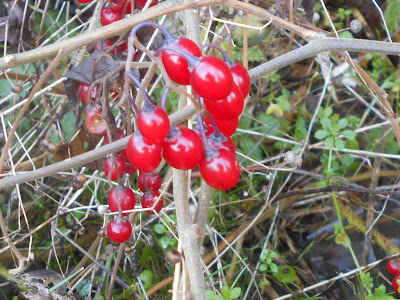Well, the first two stages were managed successfully: I did indeed get to Foxhill Farm, and I did split open some likely-looking tussocks. Part three turned out to be the tricky bit and after ten minutes I had found nowt, nothing, zilch, bugger all; my collecting tubes displayed the unadulterated quintessence of nihility.
But the weather was holding and the twigs of an ash tree formed an unmistakable silhouette against the clear but steely grey sky.
 |
The stubby twigs of ash with their soot-black buds are unmistakable.
Foxhill Farm, Badby. 29 December, 2019
|
Although beetles were proving hard to find spiders were less elusive although crouched in crevices in the damp soil they were difficult to photograph. This immature crab spider, Xysticus cristatus, could not be manoeuvred into a suitable position.
 |
Hoping not to be seen. A tiny specimen of Xysticus cristatus tries to blend
in with soil crumbs. Foxhill Farm, 29 December, 2019
|
Much the same was true of the tiny, 16-spot Ladybirds, Tytthaspis 16-punctata*, also found inhabiting crevices, although with a dozen or so to choose from I managed to get a recognisable picture.
 |
There were lots of 16-spot Ladybirds at the foot of a fence post.
Foxhill Farm, 29 December, 2019
|
Perhaps the most interesting organism I found was a jelly-like colony of a cyanobacterium. These curious organisms were a great puzzle to early naturalists and were given fanciful names like witches butter, star jelly and mare's eggs. To quote from a BBC programme in which a Scotsman was interviewed:
'Star jelly is a magical substance that makes up the sun, or meteors...and other stuff out there in the sky. When these objects from the cosmos break apart the star jelly falls gently to earth, landing in gelatinous lumps...'
In Germany it is Sternenrotz - star snot.
The species I found (in fact there were three or four colonies) was Nostoc commune, and is not uncommon in lawns. I brought a specimen home for a decent photograph to be taken.
In fact I also came home with a decent collection of spiders and beetles, plus one fly, the tiny Lonchoptera bifurcata.
* Micraspis 16-punctata in older books.
 |
Nostoc commune, found beside a gravelled track at Foxhill Farm,
Badby, Northants. 29 December, 2019
|
The species I found (in fact there were three or four colonies) was Nostoc commune, and is not uncommon in lawns. I brought a specimen home for a decent photograph to be taken.
In fact I also came home with a decent collection of spiders and beetles, plus one fly, the tiny Lonchoptera bifurcata.
* Micraspis 16-punctata in older books.









































